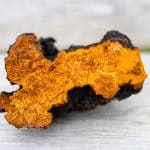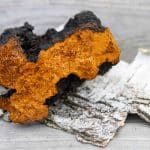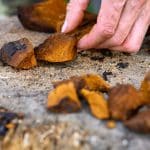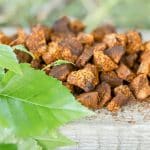Chaga (Inonotus obliquus) is a mushroom that grows mostly on Birch trees in northern Europe, eastern Europe, Asia, Canada, and the northeastern United States. It is historically known for being used in folk medicine from the 1500’s. Chaga contains large amounts of the pigment, melanin, so when exposed to sunlight, the outside of the mushroom turns dark black, and the inside remains bright orange.
Does Chaga Mushroom Increase Melanin Levels In The Body?
Chaga is known for being one of the highest sources of natural melanin in the world. It turns out melanin has a high level of antioxidants because of the amount of polyphenols that it contains. This means eating chaga will support your cells and help to maintain a balanced amount of melanin in the body.
The fungus is known for various health benefits, containing large amount of polysaccharides like Beta-glucans, which is a powerful antioxidant. Which helps in fighting free radicals and maintaining a normal cell cycle. They also serve as prebiotics, stimulating healthy gut microbiota to grow.
Learn more: Chaga mushroom benefits for hair
Chaga is one of the richest sources of melanin. On the Oxygen Radical Absorbance Capacity (ORAC) scale, chaga is a super-potent antioxidant and is naturally high in betulinic acid. At a cellular level, Chaga benefits your health by supporting normal vital functions.
What is Melanin?
We all have something in our skin called melanin, a pigment responsible for our wonderful diversity in skin tones and shades, eye colors, and hair colors. Yet, when we talk about melanin, this discussion seldom includes its actual biological benefits. The cells in our epidermis that produce melanin are called melanocytes. It turns out everyone has an equal amount, but your skin, eyes, and hair color are determined by what type of melanin and how much of it those cells make. Your body’s natural melanin production is based on your genes.
Inside melanocytes are melanosomes, responsible for producing the two types of melanin. Eumelanin, which is the darker pigment, and pheomelanin, which is a lighter colored pigment.
Skin Cancer and How It’s Related to Melanin
Eumelanin, a darker pigment, blocks UV light to hurt your skin. This means that light-skinned people are at higher risk for sun damage. Overall, the more melanin your body produces, the more defense it has against harmful rays from the sun, and the lower the risk you will get from skin cancer.
Learn more: Chaga mushroom spiritual benefits
According to skincancer.org, skin cancer is the most common form of cancer globally. More than 2 people are dying from skin cancer every hour in the United States. Having 5 or more sunburns doubles your risk for developing melanoma. While protecting against direct sunlight can be done through various means, researchers are looking into increasing eumelanin levels in those who are at a higher risk for developing skin cancer.
Use Chaga Mushroom To Increase Melanin Levels
Despite your body’s levels of melanin, studies actually suggest Chaga mushrooms promote a healthy, balanced amount of melanin in your body. The Skeletium, otherwise known as the dark, nearly black exterior of Chaga, contains massive amounts of melanin. Chaga is even known to be one of the highest sources of natural melanin in the world. It turns out melanin has a high level of antioxidants because of the amount of polyphenols that it contains, meaning consuming this mushroom helps to maintain the healthy levels of melanin and improve the health of your cells. In fact, chaga has the highest oxygen radical absorbance capacity (ORAC) of all the superfoods, ranking three times higher than Acai Berries.
Research studies are underway to see if these benefits could serve as a foundation to build cancer-fighting drugs out of “the king of mushrooms”. If you are interested in learning more about Chaga’s health benefits, please go to our post in which we go over each one in greater detail.
You can find our favorite capsules, powders, and tincture’s on the following pages of our website and learn more about each individually:















